Are you thinking of the perfect dried fruit to replace sugary snacks while packing a nutritional punch? Learning how to dehydrate kiwi is one way to go.
Kiwi fruit doesn’t always come to mind when thinking of everyday fruits you can enjoy. However, when eaten fresh or dried, kiwi fruit is quite delicious and comes with a heap of health benefits.
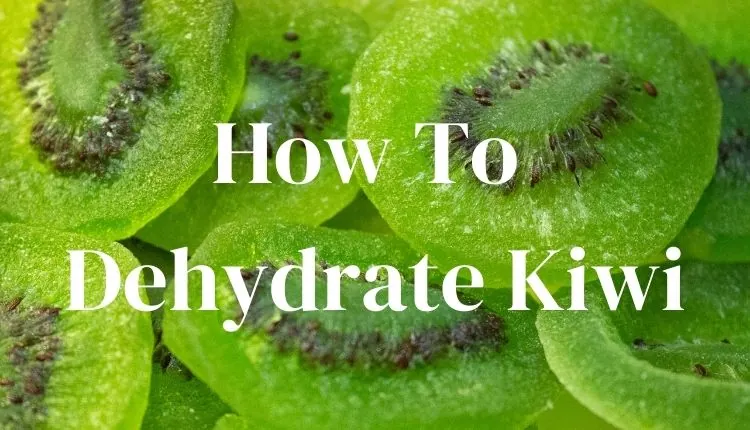
In fact, when dried, kiwi fruit becomes portable and with an extended shelf life, allowing you to enjoy them beyond the comfort of your home.
You can snack on these healthy treats in the backcountry during hiking, backpacking, or even as a mid-afternoon snack to give you an extra energy buzz at work. While store-bought dried kiwi lasts longer and looks prettier, it doesn’t compare to home-dried kiwi.
After all, commercially available kiwis are usually treated with sulfur dioxide and a bunch of other chemicals to prolong their shelf life and enhance their color and look. Unfortunately, these unnatural chemicals may pose some problems, including triggering asthma symptoms.
This explains why it’s a better idea to dehydrate your own fruit at home. So, here’s an easy-to-follow guide on how to dehydrate kiwi at home so you can enjoy these toxin-free, all-natural, and nutrient-dense snacks.
Does Dehydrating Kiwi Strip it off Its Nutrients?
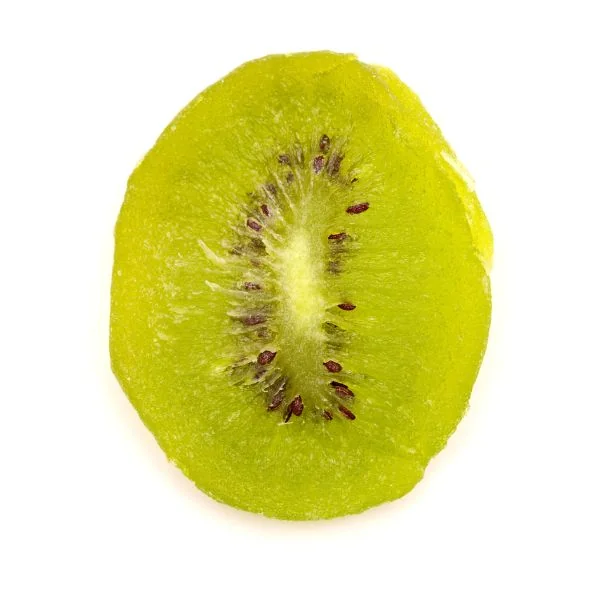
Dehydrating kiwi will not strip off its nutrients. Dehydrated kiwi pretty much retains most of the nutrients of a fresh kiwi.
The only difference is that when you dehydrate kiwi, water is drained from it, leaving its nutrients concentrated.
For example, when properly dehydrated, dried kiwi fruit will contain more than three times the weight of fiber and minerals, like folate, compared to fresh kiwi fruit. This also explains why you may notice a more intense flavor in dried fruit compared to fresh fruit.
Further, removing all of the water content from the fruit is what significantly reduces the size of the dehydrated fruit.
Why Dehydrate Kiwi?
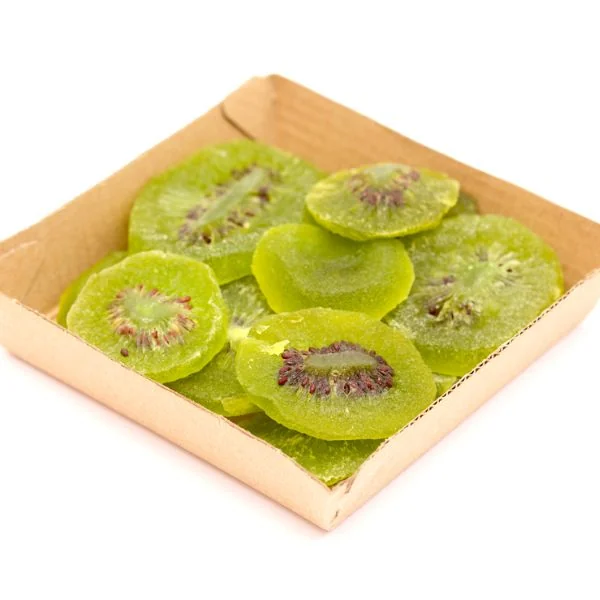
Dehydrated kiwi comes with several health benefits and allows you to sample a myriad of fun recipes. Each dried kiwi contains a generous serving of antioxidants, fibers, proteins, minerals (like folate and potassium), and vitamin C.
Therefore, regularly consuming kiwi fruit aids in boosting immune function and prevents respiratory problems such as asthma.
On the other hand, the fiber content promotes digestive health while vitamin C improves cellular health. The flavor profile of dried kiwi also makes it a fun ingredient for many recipes.
When dehydrated, the fresh flavors of kiwi fruit become concentrated to create a sweet and slightly tangy flavor – similar to that of sweet and sour gummies.
They also have a fun bright green color, reminiscent of candy. Therefore, you can nibble on a few dried kiwis daily as a substitute for candy.
The advantage is that you snack on a delicious treat while taking in its rich nutrients.
However, dried kiwi fruit is not just limited to candy! The fruit is quite versatile, and can even be incorporated into special diets, such as paleo diets.
Here’s how you can use dehydrated kiwi in different recipes:
- Replace candy with healthier dried kiwi – dried kiwi tastes like sweet and sour gummy, only healthier
- Pair it with other dried fruits like blueberries and raspberries for a healthy, low-sugar snack
- Add to cereal, smoothies, or yogurt
- Incorporate to breakfast and superfood salad bowls
How Long Do Dehydrated Kiwi Last?
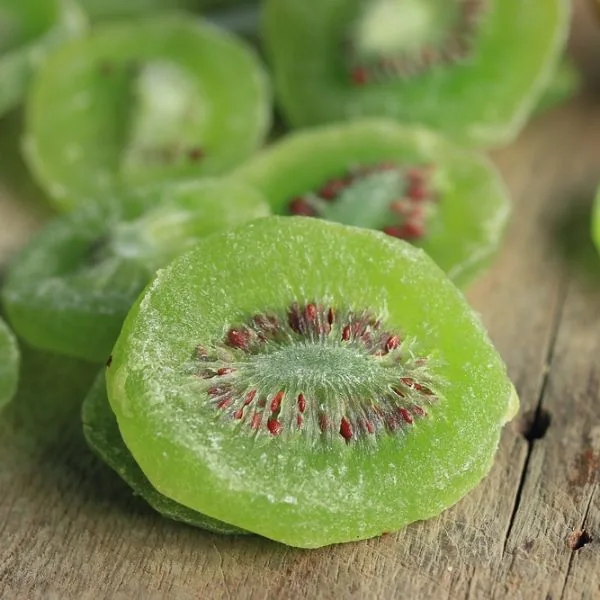
Prepared, dehydrated, and stored properly, home dehydrated kiwi lasts anywhere between 12 and 18 months.
But, this doesn’t mean that the kiwi will go bad within this time. With proper storage, dried kiwi remains safe to consume beyond 18 months of storage – just that the quality and taste slightly degrade.
In fact, stored in airtight, vacuum-sealed containers in dark, dry, and cool environments under 70 degrees Fahrenheit, dehydrated kiwi can last up to 5 years. On the other hand, dehydrated kiwi that is properly sealed and stored in a freezer at zero degrees Fahrenheit will last you indefinitely.
Kiwi dehydrated in an oven or air fryer will last you for a few days to weeks, even when stored in the refrigerator. This is because drying kiwi in the oven or air fryer doesn’t pull out all the water content.
How Long Does It Take To Dehydrate Kiwi?
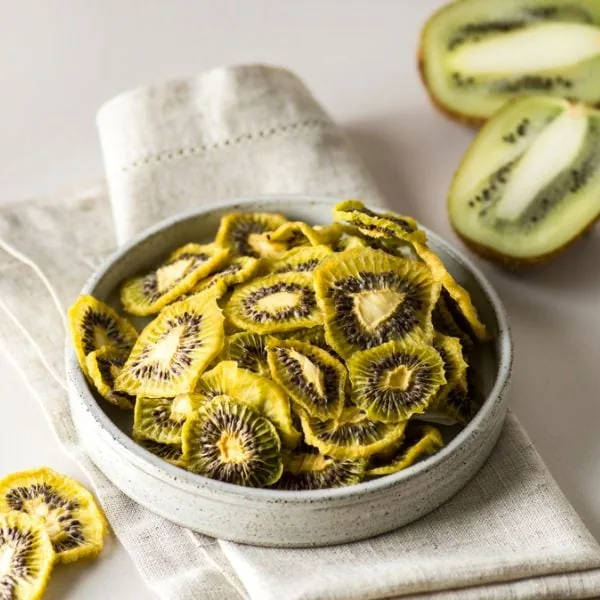
Dehydrating kiwi in a dehydrator takes about 10 to 18 hours. The actual duration is influenced by many factors.
These include how the kiwis are cut and the type of dehydrator used, to mention a few. However, it takes significantly less time to dehydrate kiwis in the oven or air fryer.
But, they don’t do as effective a job at pulling out all the water and moisture content to allow for long-term storage.
Special Factors In Dehydrating Kiwi In A Dehydrator
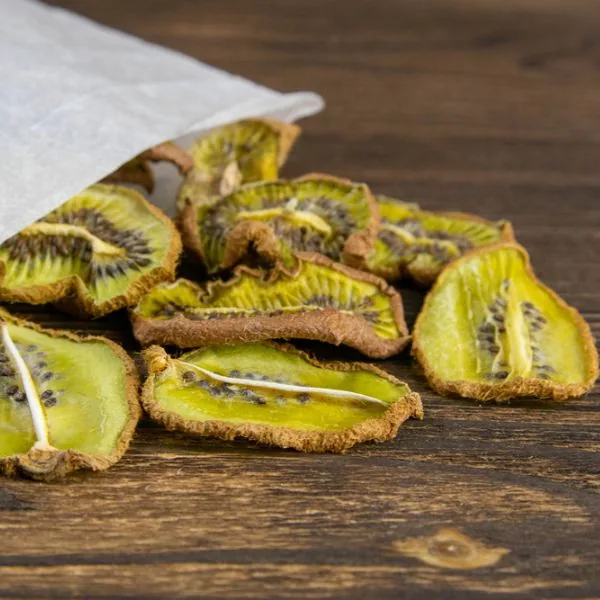
Several key factors play a role in your dehydrating process, no matter the food item you are drying. To ensure you get the best results, you want to pay attention to the right prep, dehydrating, conditioning, and storage practices.
Moreover, you want to pay attention to factors, like the temperature, drying time, and type of dehydrator you use. However, you also want to take note of special features in relation to drying kiwis. These include:
- Type of Kiwi: To get the best results with delicious and sweet-tasting dried kiwis, always go for ripe ready-to-eat kiwis. Fresh kiwis usually get softer and sweeter as they ripen. Ripe kiwis work great for all types of dehydrating techniques, whether sun drying, using a dehydrator, or oven. To know your kiwi is ready for dehydrating, hold it in the palm of your hands and gently squeeze it. It should give in a little but remain somewhat firm. If you have unripe kiwis, there’s always a way to expedite the ripening process. If your kiwi is unripe and firm, all you do is leave them in a bowl on your kitchen counter at room temperature for about 2 to 5 days to ripen them. If you want to ripen your kiwis much faster, you can place them near fruits that emit ethylene gas, like bananas, apples, or oranges. The ethylene gas speeds up the ripening process. Don’t leave them out for too long as this may over-ripen the kiwis.
- Pretreat: As mentioned above, the process before and after actual dehydration affects the overall results. Therefore, you want Pretreat your kiwis before drying them. You will notice that store-bought dehydrated kiwis maintain a bright, vibrant, and long-lasting color while maintaining long shelf life. This is because commercially available dried kiwis are treated with numerous chemicals, including sulfur dioxide to give them these qualities. But, this may not work for people who want all-natural dried foods. After all, the chemicals may have adverse health effects in the long run. The good news is that you can maintain a bright color and extend the shelf life of your home-dried kiwis. You can use ascorbic acid (AKA vitamin C) to pretreat your kiwis before dehydrating. All you do is combine a glass of water with about a tablespoon or two of ascorbic acid powder (readily available at the nearest grocery store) and dip each fruit into the mixture before drying it. The benefit of using ascorbic acid is that it replenishes some of the vitamin C the fruit loses during the dehydration process.
- Storage: The storage of your kiwi fruits is extremely important for maintaining a longer shelf life. Always pay attention to the humidity, oxygen, light, and temperature levels. The lesser the levels of these factors, the longer your dried fruit will last. So, always keep your kiwis in a dry, cool, and dark environment with airtight packaging (to restrict oxygen from coming in contact with the dried fruits).
How To Dehydrate Kiwi In A Dehydrator
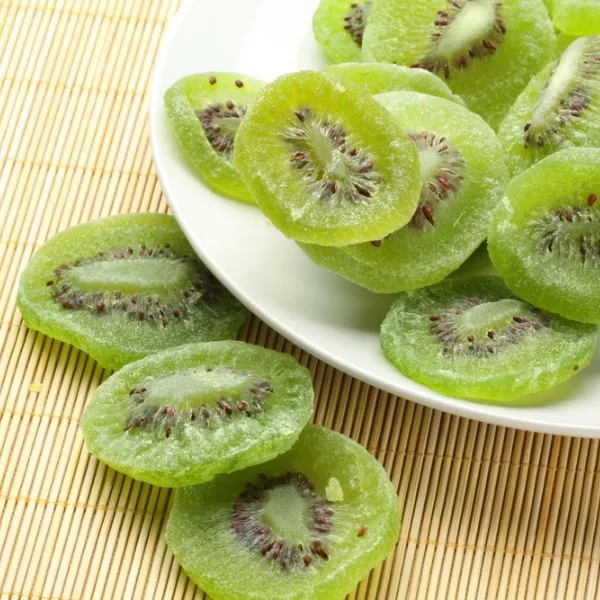
Here’s how you can dehydrate kiwi in a dehydrator at home:
Tools and Ingredients Needed
- Metal colander
- Ripe kiwis
- Paring knife
- Small spoon
- Water
- Ascorbic acid powder
- Small bowl
- Sugar
- Dehydrator
Duration
Preparation time: 15 minutes
Drying time: 10 to 18 hours
Instructions
Here’s a step-by-step guide to drying kiwis:
Step 1: Have Your Equipment Ready
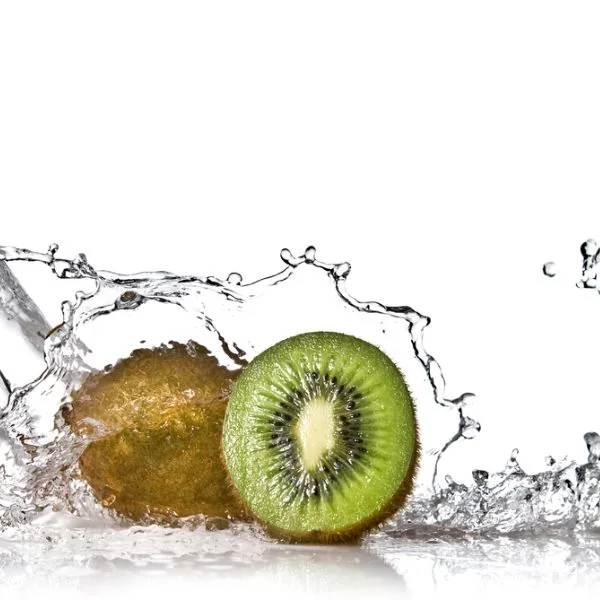
Before you begin with the dehydrating process, always get all your equipment and ingredients ready. Make sure your equipment is clean and sanitized to avoid possible contamination.
Next, transfer the kiwis to a metal colander and wash them thoroughly under running water, removing any debris. If you notice very soft or mushy, over-ripened kiwis, remove those too.
Once done, you can proceed with the pretreatment process.
Step 2: Pretreat & Prep
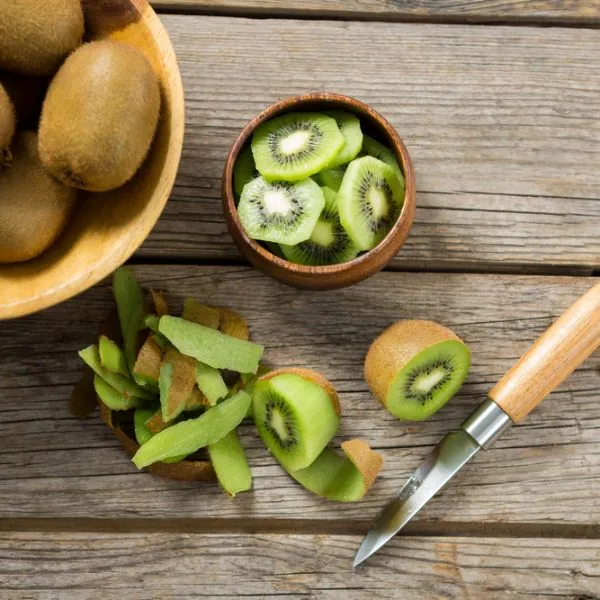
Use a paring knife to cut the kiwi in half and peel out the entire skin. You can use the knife or spoon by placing it between the flesh and skin, for easy peeling.
This step is optional as some people choose to leave the edible skin on. If you choose to leave the skin on, make sure you thoroughly scrub it to remove any impurities and debris.
Next, use the paring knife to thinly slice the kiwis (make about a quarter of an inch cuts) to yield about 5-8 slices, depending on the size of the kiwi fruit.
The thin slices allow for faster drying. During slicing, try to maintain even slices to ensure even drying.
Make an acid mixture – combine a glass of water with one to two tablespoons of ascorbic acid powder in a bowl and dip each kiwi slice briefly into the mixture.
Step 3: Arrange Kiwis on the Dehydrator Trays
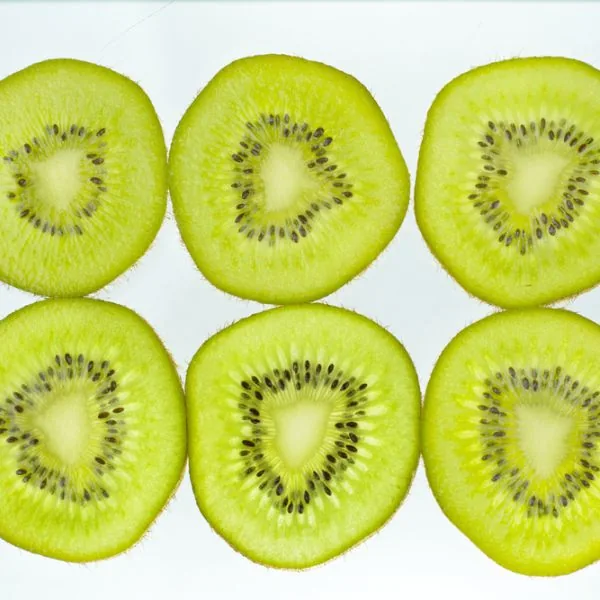
Line each kiwi slice on the dehydrator trays, one by one.
You want to leave at least a quarter of an inch space between each kiwi slice to allow for even and thorough drying. Sprinkle each slice with a pinch of sugar, if you want to.
This process helps to balance out some of the intense sour hints you may get from the fruit after dehydrating it.
Step 4: Dehydrate the Kiwis
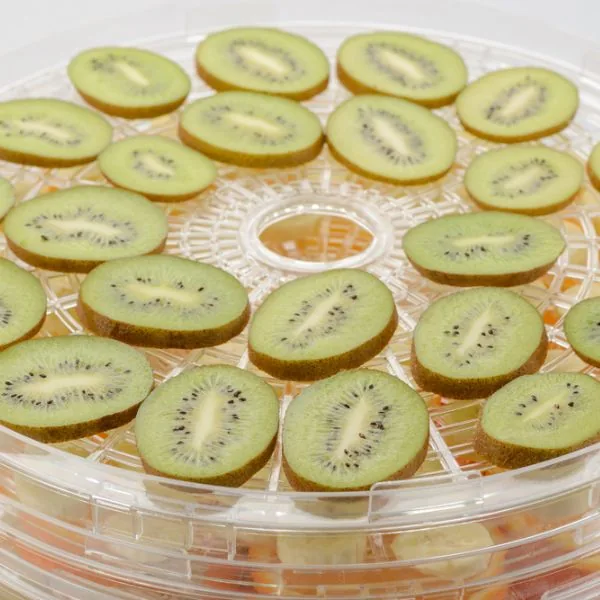
Transfer the kiwi trays into the dehydrator and dry them for about 10 to 18 hours at 135 degrees Fahrenheit. After about 6 hours, check the kiwi for progress and rotate the trays for even drying, depending on the type of dehydrator you are using.
How Do I Know My Kiwis Are Adequately Dehydrated?
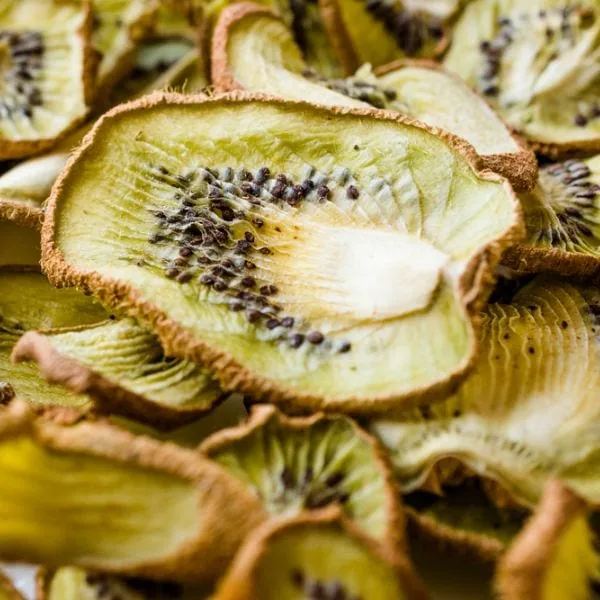
You will know your kiwis are adequately dried by their leathery texture. Once done with the dehydrating stage, remove a slice or two, and let them completely cool.
The slices may be slightly bent but they will not snap or tear easily when pulled. When you squeeze the kiwis, you should not see any moisture or water seeping out.
If you notice any moisture, you want to pop the kiwis back into the dehydrator and dry them a little longer.
How to Store Dehydrated Kiwi
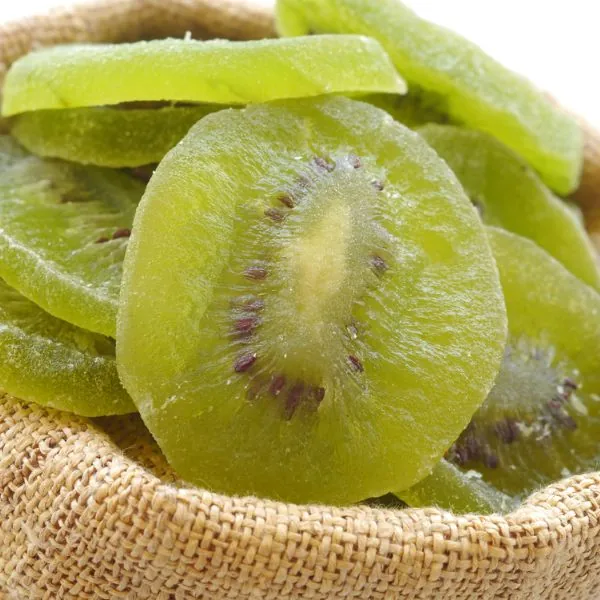
You can store dehydrated kiwis in several ways, depending on the results you want. Primarily, you can opt for short-term or long-term storage.
Short Term Storage
If you plan on consuming your kiwis within a few days, pop them out of the dehydrator and let them cool completely.
Then, transfer them to a sealed container or resealable bag and store them in a cool, dry, and dark place. You can also refrigerate the kiwis. Kiwis dehydrated in an oven or air fryer are ideal for short-term storage.
Long Term Storage
If you plan on storing your dried kiwis for longer, the process is a little different. First, you have to condition the kiwis before storage.
When conditioned and stored properly, dehydrated kiwis will last for up to 18 months, retaining the same flavor quality and appearance.
Condition The Dehydrated Kiwis
Conditioning dehydrated foods simply means balancing out any residual moisture left behind after the dehydration process.
This step is essential in ensuring your food will last longer when stored. There are two methods to condition dehydrated kiwis.
You can leave them in the dehydrator to cool and let them condition overnight or for up to two days.
After two days, pop the dehydrator and check each slice for moisture or mold build-up. If you notice any moisture, it means that the kiwis aren’t adequately dried.
So, return them to the dehydrator and repeat the steps. However, if you notice any mold build-up, it means that the kiwis weren’t properly prepared or dehydrated.
So, you will have to discard them. Alternatively, remove the dehydrator trays containing the dried kiwis and let the kiwis cool completely.
Next, loosely pack the kiwis in a see-through container and leave them on your kitchen counter for about 3 to 5 days. During this time, you want to shake up the container daily to prevent the kiwis from sticking to each other and to prevent creating an environment for moisture to build up.
After 5 days, check the kiwis for any signs of moisture or mold. if you don’t notice any, you can proceed with storage.
Storage Options
When it comes to long-term storage, you have plenty of options. Here are some of the common ones:
- Option A (Freezing): Transfer the kiwis into a clean and airtight container and freeze them for up to a year. For this process, you can make multiple batches to consume on different days. This is because once you remove the kiwis from the freezer and thaw them, you cannot refreeze them as they would’ve been rehydrated by them.
- Option B (Vacuum sealing): Store the kiwis in a clean, airtight container or Mylar bag and vacuum seal it using a home vacuum sealer. Just like freezing, you want to divide the kiwis into multiple batches if you don’t plan on consuming them in one go. After vacuum-sealing the container or bag, store it in a cool, dry, and dark place.
- Option C (Extra Preservation): If you live in a humid environment, add the kiwis in an airtight container or Mason jar and add a moisture absorbing pack/desiccant. This will help counter any possible moisture build-up.
Whether you go for option A, B, or C, you want to clearly label each package with the correct dates so you can keep track of their shelf life. This also ensures you don’t consume food that may have gone bad.
Summary of Dried Kiwi Storage
Here is a summary of projected shelf life for dehydrated kiwis stored in different locations:
- Pantry 12 to 18 months
- Pantry (in a cool, dry, and dark place) with moisture absorbers (desiccants) or oxygen absorbers: Up to 5 years
- Refrigerator: 12 to 18 months
- Freezer: 18 months to indefinitely
FAQs
Do you still have questions about dehydrating kiwis? Here are commonly asked questions to help you out:
What Other Methods Can You Use to Dehydrate Kiwi?
In addition to a dehydrator, you can also dehydrate kiwis using an air fryer, oven, or microwave. You can also freeze-dry or sundry your kiwis.
How Do I Dehydrate Kiwi In An Air Fryer?
Here’s how you dehydrate kiwi in an air fryer:
- Transfer kiwis into a metal colander and wash them thoroughly under running water, removing any mushy ones along with any debris.
- Use a paring knife to peel off the skin of each kiwi fruit. This process is optional, depending on the texture you want to achieve. Leaving the skin creates two different interior and exterior textures.
- Slice each kiwi into thin quarter-of-inch slices using a paring knife, maintaining the same size for even drying.
- Line the air fryer basket/tray with parchment paper and lightly grease it with cooking oil spray.
- Transfer the kiwi onto the paper-lined basket/tray, leaving enough space between each kiwi for optimal airflow and even drying. Lightly coat each kiwi slice with cooking oil spray.
- Set the air fryer to about 130 degrees Fahrenheit (some air fryer models even come with a dehydrator setting) and air fry your kiwis.
- Let them air dry for about four to five hours or until they turn dry and leathery.
- Remove the basket/tray from the air fryer, let the kiwis cool, and transfer to an airtight container for storage in a dark, dry, and cool pantry or the refrigerator.
How Do I Dehydrate Kiwi In An Oven?
- Place the kiwi in a metal colander and wash them under running water, removing debris and over-ripened ones. Set them aside to let them dry.
- Skin the kiwis using a paring knife (optional) and slice them into thin quarter-of-an-inch slices.
- Line the baking pan with a baking sheet or parchment paper and lightly coat it with cooking oil spray.
- Transfer the kiwis to the pan, leaving enough space between each kiwi.
- Bake the kiwis for about three to four hours.
- Once done, remove them from the oven, let them cool completely, and transfer them to an airtight container. You can store them in a cool, dark place in the pantry or inside the refrigerator.
How Long Does Dried Kiwi Last in A Freezer?
When properly packaged and stored in the freezer, dried kiwi will last you for up to 18 months. Frozen at zero degrees Fahrenheit, dried kiwis will last you indefinitely.
However, while the kiwis remain safe to consume, they will lose some of their taste and quality over time.
Is It Better To Store Dehydrated Kiwi In A freezer?
It all depends on your preferences. However, if you reside in a warm to a hot, humid climate, you should store your dehydrated kiwis in a freezer if you want them to last you longer.
Alternatively, you can keep them in the refrigerator, where when stored properly, they will last about 18 months.
How Do You Tell Dried Kiwi Has Gone Bad?
Most of the time, you can easily tell dried kiwis have gone bad when there is mold growing on them. Additionally, kiwis that have gone bad will have a degraded appearance and will give off a foul smell.
Conclusion
Knowing how to dehydrate kiwis at home allows you to add an extra snack item to your diet, without the sugar punch. You can also integrate kiwis into your daily diet, whether by adding them to your salad or other meals.
Consuming these sweet-sour treats daily is also a great way to replenish your nutritional supply of vitamins, minerals, and antioxidants. Plus, the advantage to mastering the technique of home drying your own kiwis is that you will enjoy the same supply of delicious and fun-colored treats packed with nutrients.
But, you won’t have to worry about an excessive amount of chemicals like those added to store-bought dried kiwis.





Donaldina is a home cook and writer who enjoys experimenting with different flavors. She loves to take her readers on a fun-packed, palate pleasing journey through different recipes. Along the way she recommends the best equipment and tools to prepare tasty meals. Enjoy the adventure!